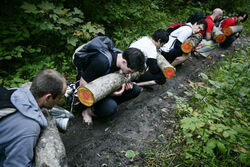
A group of traceurs training with the 'Méthode Naturelle' during a Parkour Generations Training Camp. 'Méthode naturelle' is the oldest form of conditioning used for Parkour.
Conditioning is a vital part of a Traceur's or Traceuses' training. Conditioning prepares and maintains a healthy body and mind before, during, and even after training. Conditioning can be used with a variety of methods, and styles. General areas conditioned include stamina, strength, various techniques, and even the conditioning one's way of thought. Proper conditioning has a great number all long term health benefits, even outside of Parkour training.
Early Stages[]
Conditioning is vital during the early stages of one's training. Conditioning will help prepare one's body for the rigorous training and the demands it places on the body. Conditioning is viewed to be more important before serious periods of training. Conditioning is commonly exercised several times a week before a practitioner starts his or her training. Conditioning can take the form of simple workouts, such as quadrupedal movement, squats, crunches, pushups and pullups, or they can be more challenging, such as muscle ups, clap push-ups, or excercises using weights such as squats or deadlifts. Starting Parkour before one's body is properly conditioned to meet the demanding training can result in injury. Early conditioning is a great way for a traceur or traceuses to improve his or her weak points and improve mental and physical health all around.
Types of Conditioning[]
There are many types and levels of conditioning. There are conditioning styles and routines to meet all types of movements and environments. Conditioning is highly adaptable and so many practitioners have created their own personal conditioning styles to meet their goals or improve in a specific area. Since creativity can conform conditioning into new, personal styles, there are an endless amount of types. Some popular areas focused on when conditioning include, basic body building, stamina, endurance, patience, focus, awareness, upper and or lower body strength, improvement of techniques, and learning quadrupedal movement. Generally, all types of movements, and mental skills, can be improved by conditioning.
'Méthode Naturelle'[]
'Méthode Naturelle' or 'Natural Method' was created by Georges Hébert in the early 1900s. Georges Hébert's 'Natural Method' is an extended period of training in nature for 20 to 60 minutes, moving in a spontaneous or planned course, using his ten fundamentals, which included walking, running, jumping, quadrupedal movement, climbing, balancing, throwing, lifting, defending and swimming.
This method would go on to become the first form of 'parcour', a type of obstacle training, which later would be a core factor in the creation of Parkour. The Belle family, who is credited for the creation of Parkour, trained using Georges Hébert's 'Natural Method' and his parcours.
Today, Méthode Naturelle' is used by practitioners as a form of conditioning and training. It is still trained in nature, almost unchanged since its creation. Practitioners know this type of training to be one of the 'purest' and to some the most fulfilling, as it spawned into the core elements and philosophies of Parkour.
Mental Conditioning[]
Many practitioners say training one's mind is just as important as training the body. A Traceur or Traceuses may train his or her mind for a number of reasons. Increasing patience and determination, routing fear properly, learning how to interpret the world around you, expanding your creative and critical thinking, and learning understanding and acceptance, are all by products of mental conditioning. Having the right mindset will increase your view of not only training, but also the world around you and how you view it. Similarly with physical training, many practitioners say mental training has helped them outside of Parkour in their everyday lives.
